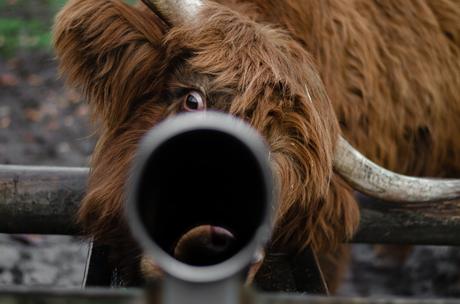Drovers’ roads were routes along which cattle were driven to market, often from the Highlands and islands to the Lowlands of Scotland. Improvements in agriculture and the move towards enclosed systems of fields lessened the need for drovers. The introduction of alternative methods of transportation for cattle – such as steam ships and railways – also resulted in a decline in the use of drovers’ roads and the practice had largely died out by the beginning of the 20th century.

The Perthshire town of Crieff became synonymous with cattle droving and was the location of the annual Michaelmas cattle market, known as the Crieff Tryst, when as many as 30,000 black cattle would arrive in the town. Drovers would bring the cattle to market from as far away as Skye, a distance of over 200 miles.
Those who drove the cattle were much-valued in the Highlands. It was a tough existence. Drovers tended to work long days, although usually they would only travel around ten miles in this time, and lived off a basic diet of oats and whisky, supplemented with the occasional onion. They had to navigate some extreme geographical obstacles and it was important they knew their route well. To spend the night in one of the many drovers’ inns would have provided welcome respite to the rigours of the journey, although they also had to be alert to the ever-present danger of cattle rustlers and marauders. As well as knowledge of the terrain, the drovers also needed to be hardy and resourceful in order to endure the extreme conditions they faced. Quite often they would meet with an unwelcoming local populace in the Lowlands, where the locals found them wild and uncivilized.

On a busy drove road, there were often inns situated approximately every four miles along the route. Most of these drovers’ inns have long since disappeared, or been adapted into farms or private houses. However, situated in the hamlet of Inverarnan at the top end of Loch Lomond, along the route of the West Highland Way, the Drovers’ Inn can be found. It has been in existence since 1705 and has remained just as popular as it was 300 years ago. In that time it has been a stopping-off point for various famous visitors, including reputedly Samuel Johnson (1709-1784) and James Boswell (1740-1795). Johnson, the English writer, and his Scottish biographer James Boswell famously toured the Western Isles of Scotland in the late 18th cetury, a journey they both later wrote about in separate journals.
Although there are 14th century documents in existence which specifically mention the passage of drovers through England, the trade suffered badly due to the Wars of Independence and the on-going struggles between the two nations. Following the ascension of James VI to the throne of England as James I, free movement between Scotland and England helped the trade flourish. It also benefited from the suppression of the Border Reivers – cattle rustlers in the Border country between Scotland and England – and became a fairly lucrative trade. It is estimated that over 30,000 cattle annually crossed the border in the early 18th century.
Having to travel such long distances, a particularly peculiar necessity came about. Drovers began “shoeing” their cattle, just like you would see on horses today. Cattle could not arrive to market lame or limping. They had to look as healthy as when they started in order to command the best price. Therefore, for their long journey, drovers would shoe the cattle to keep their legs and hooves healthy on the journey ahead.
Though cattle droving may no longer be in existence today, this once flourishing trade is evident in the surviving trails and tracks that can be traced in many parts of Scotland.
